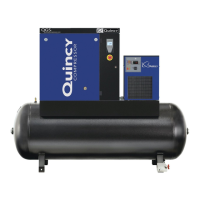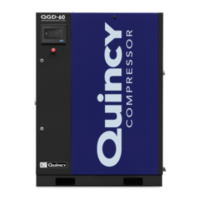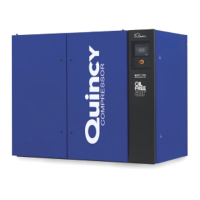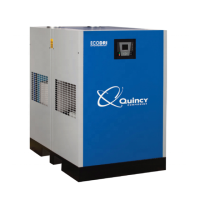SECTIONII - DESGYUPTION
..
*General Description - QMA Series
*Compression Cycle
*Air Flow
*Fluid Flow & Cooling System
*Schematics
*Air/Fluid Resewoir & Separator Element
*Capacity Control System
*Electrical System
*Indicators and Gauges
(!)MA Series Air Compressors
The compressor is a single stage, positive displacement,
fluid-flooded, helical screw type unit. The compressor
consists of two ductile iron rotors. On 50/60/75 HP
series the female rotor is directly driven from the motor
through a flexible non-lubricated, drop-out type
coupling. On the 100/125/150 horsepower series the
male rotor is directly driven. The female rotor has six
flutes that mesh with a male rotor consisting of four
lobes. Both rotors are housed in a single cast iron
cylinder. The unit has an inlet port at the power input
end and a discharge port at the opposite end. Both
rotors are mounted on cylindrical bearings on the
suction end and on tapered roller bearings at the
.
discharge end.
The compressor is encased by a steel air/fluid reservoir
bolted to the compressor flange. Au adapter positively
locates the drive motor to the compressor ensuring
permanent alignment of the components.
The fluid is circulated throughout the machine by
pressure ditTerential. Positive pressure maintained in
the reservoir, pushes the fluid through the system.
The drive motor, and reservoir are mounted on rubber
isolators located to a steel frame for quiet operation.
An acoustical cabinet surrounds the motor and provides
support for the air/fluid coolers and fan motor.
Controls and indicators are arranged on an instrument
panel.
The Compression Cvcle
The compression cycle of a rotmy compressor is a
continuous process from intake to discharge with no
reciprocating mechanisms starting and stopping as
found in reciprocating compressors. The compressor
consists of two rotors in constant mesh, housed in a
cylinder with two parallel adjoining bores. All parts are
machined to exacting tolerances.
& the rotors revolve, (counterclockwise as viewed
from the power input end on models 50/50H & 75 and
clock wise on models 100/125 & 150) air is drawn into
the cylinder through the inlet port located at the power
input end. A volume of air is trapped as the rotor lobes
pass the inlet cut off points in the cylinders.
Compression occurs as the male rotor rolls into the
female flute progressively reducing the space thereby
raising the pressure. Compression continues until the
lobe and flute pass the discharge port. The compressed
air is then discharged. There are four complete
compression cycles for each complete revolution of the
male rotor.
Air Flow
With the compressor operating, a partial vacuum is
produced at the compressor inlet. Air entering, via the
compressor air filter, flows through the air inlet valve
into the rotor housing where it is compressed, then
discharged within the air/fluid reservoir. The air
discharged from the compressor contains fluid which is
removed from the air as it passes through a fluid
separator located within the air/fluid reservoir.
Compressed air then passes through a cheek valve to
the service connection.
The quantity of air entering the compressor is regulated
by the air inlet valve located between the air filter and
the compressor inlet port. The position of the air inlet
valve is automatically controlled during normal
operation by air demand. When the inlet valve is in the
closed position it serves as a check valve, preventing the
back flow of air or fluid into the air filter.
The air/fluid reservoir is equipped with a pressure relief
valve to protect the system in the event of a malfunction
in the capacity and pressure control systems. The
standard air/fluid reservoir is rated at 175 PSIG
working pressure. A minimum pressure feature is
provided in the service line to limit the maximum air
velocity through the separator.
Fluid Flow and Coolin~ System
The fluid in the system serves three fimctions: it
lubricates the bearings and the rotors, it seals rotor
clearances to improve etllcieney, and it removes heat
from the air as the air is being compressed, thus
lowering the compressed air discharge temperature.
Air pressure in the air/fluid reservoir forces fluid out of
the reservoir, through the fluid cooler, (figure 2-l),
through a fluid filter and then into the compressor. In
the compressor, some of the fluid is diverted directly to
the bearings through internal passages to insure positive
lubrication to the bearings. The remainder of the fluid
27
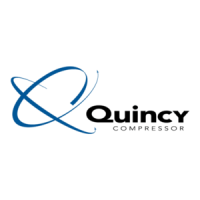
